Single-cell immune profiling and validation of PBMCs in the onset of and recovery from herpes zoster
- PMID: 39633072
- PMCID: PMC11618686
- DOI: 10.1038/s42003-024-07289-w
Single-cell immune profiling and validation of PBMCs in the onset of and recovery from herpes zoster
Abstract
To gain deeper insights into pathogenesis of herpes zoster, the peripheral blood mononuclear cells (PBMCs) from male patients mostly were subjected to single-cell RNA-seq (scRNA-seq) and ATAC-seq analysis. Here we show a detailed immune cell profile in the onset of and recovery from herpes zoster, revealing proportion alterations of the subpopulations, which were validated by flow cytometric analysis and comparison of blood routine data. The integrative analysis of the transcriptomes and epigenomes provided a comprehensive description and validation of the key changes in peripheral blood. This study may provide deep insight into the immune profile during herpes zoster progression and holds potential clinical significance.
© 2024. The Author(s).
Conflict of interest statement
Competing interests: The authors declare no competing interests.
Figures

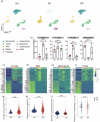
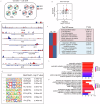
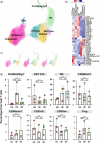


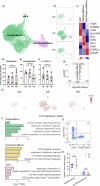
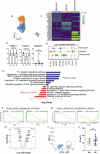
Similar articles
-
No detectable alloreactive transcriptional responses under standard sample preparation conditions during donor-multiplexed single-cell RNA sequencing of peripheral blood mononuclear cells.BMC Biol. 2021 Jan 20;19(1):10. doi: 10.1186/s12915-020-00941-x. BMC Biol. 2021. PMID: 33472616 Free PMC article.
-
Single-cell characterization of a model of poly I:C-stimulated peripheral blood mononuclear cells in severe asthma.Respir Res. 2021 Apr 26;22(1):122. doi: 10.1186/s12931-021-01709-9. Respir Res. 2021. PMID: 33902571 Free PMC article.
-
A distinct immune landscape in anti-synthetase syndrome profiled by a single-cell genomic study.Front Immunol. 2024 Oct 24;15:1436114. doi: 10.3389/fimmu.2024.1436114. eCollection 2024. Front Immunol. 2024. PMID: 39512337 Free PMC article.
-
Heterogeneity of immune cells in human atherosclerosis revealed by scRNA-Seq.Cardiovasc Res. 2021 Nov 22;117(13):2537-2543. doi: 10.1093/cvr/cvab260. Cardiovasc Res. 2021. PMID: 34343272 Free PMC article. Review.
-
Varicella virus-mononuclear cell interaction.Adv Virus Res. 2003;62:1-17. doi: 10.1016/s0065-3527(03)62001-4. Adv Virus Res. 2003. PMID: 14719363 Review.
References
-
- Harpaz, R., Leung, J. W. The Epidemiology of Herpes Zoster in the United States During the Era of Varicella and Herpes Zoster Vaccines: Changing Patterns Among Older Adults. Clin. Infect. Dis., 10.1093/cid/ciy953/5213085 (2018). - PubMed
-
- Rafael Harpaz, J. W. L. The Epidemiology of Herpes Zoster in the United States During the Era of Varicella and Herpes Zoster Vaccines: Changing Patterns Among Children. Clin. Infect. Dis., 10.1093/cid/ciy954/5213086 (2018). - PubMed
-
- Chen, M.-H. et al. Risk of depressive disorder among patients with herpes zoster: a nationwide population-based prospective study. Psychosom. Med.76, 285–291 (2014). - PubMed
MeSH terms
LinkOut - more resources
Full Text Sources
Medical

